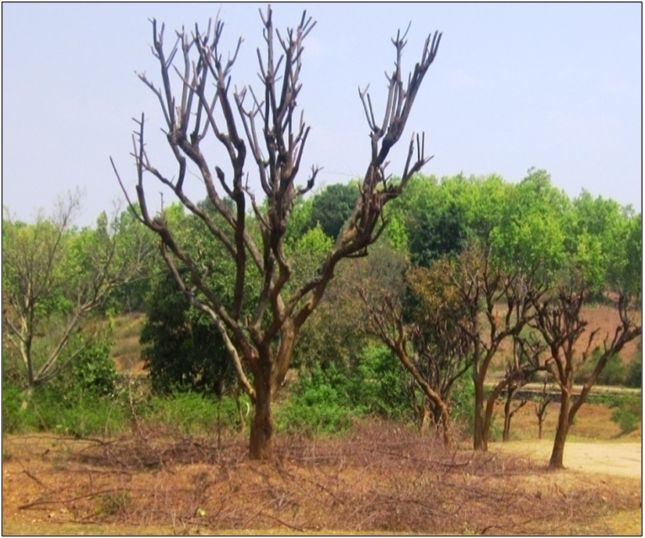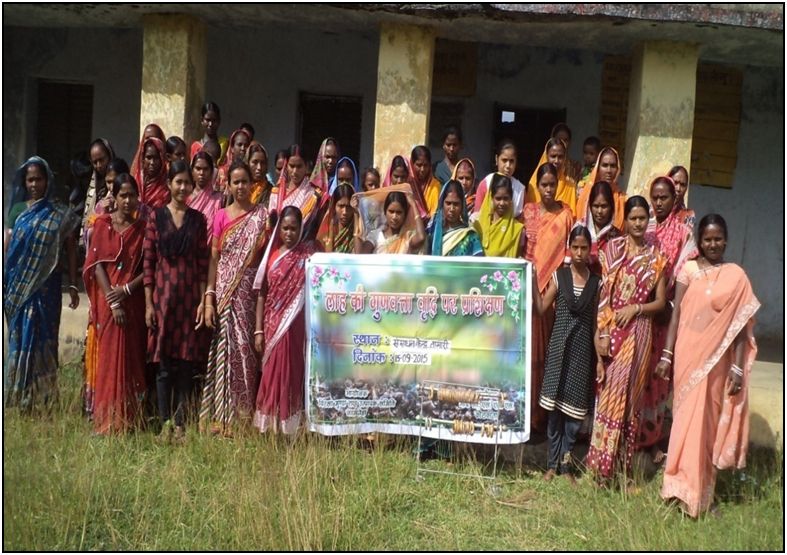
The farmers of Jharkhand have long been depending on lac farming for their livelihood. Lac, a resin extensively used in preparation of a range of products - from cosmetics to ammunition - is cultivated on a variety of trees, mostly fruit-bearing and shady trees like Ber, Kusum, Palash and Sal. Jharkhand is the biggest lac-producing state in the country and accounts for more than 50 percent of the national produce.
“Host trees for growing lac are abundant in Saraikela-Kharswan district in Jharkhand. Yet the crop, which had been a lucrative source of income, was on the decline just a few years back,” says Manas Das, who works for a Jamshedpur-based NGO, Technology Resource Communication and Service Centre (TRCSC). The state, which had the potential to produce as much as a lakh tonne of lac annually, was barely producing 9800 tonne on an average during the period, 2003 to 2010. “The farmers infested the trees with lac insects during the monsoons. The area, however, lost its status as an up-and-coming lac-producing zone by 2008,” Das adds.
Cooperative takes shape

Forging a lac cooperative in Ichagarh block of Saraikela-Kharswan district, Jharkhand, changed the scene. It cleared the path for lac producers in the area just when things had begun to look bleak for the sector. The cooperative, named by the locals as ‘Birsa Munda Lah Utpadan Sahyog Samiti’ (Birsa Munda Lac Producers Cooperative Society), has been working towards helping the locals make lac farming profitable. “The marketing and distribution system for lac was controlled by private traders and middlemen, and farmers were forced to sell their produce at throwaway prices. Gradually, the awareness dawned on the farmers that they needed to form some sort of an organization,” says Tilak Oraon, president of the cooperative.
The lac cooperative was set up in 2011 and formally registered under the Cooperative Act (1935) the following year in response to the production and the procurement concerns. The idea was to improve the production system and develop the cooperative as a business enterprise - owned, managed and controlled in accordance with democratic principles. The cooperative was to serve the needs of its own members, and not just stand for profit or help the non-members.
Membership in the cooperative was voluntary and was open to all. Most of the members already have lac host-trees in their private lands and showed interest. The membership fee was nominal at just Rs 100. The cooperative, which began with just over 100 members, has doubled its membership spanning a dozen gram panchayats in the district. After completion of three years, a general body meeting was organized to elect new officials.
The way it was
The forest department used to distribute saplings of lac host-trees among farmers who were interested in taking up lac cultivation in the area as a part of afforestation drive, just before the monsoons. Yet, the branches barely got laden with lac. “At times, the farmers would repeatedly infest the trees with insects but would end up getting barely a few kilograms of lac, while a tree has a potential of producing about 10 kg. Unbearable heat in March and April, followed by poor monsoon, made the resin melt, killing the brood lac,” says Jagabandhu Mahato, a member of the cooperative. Often, farmers suffered losses given the outdated techniques used for growing the crop. “Many felt that there was a problem with the tree or the insect while the others blamed it on the climatic conditions,” he adds. “During March and April, the heat is unbearable. This excessive heat makes the resin melt, killing the small insects, leaving hardly any insect to infest the next crop,” says Arup Banerjee, another farmer-member of the cooperative.
Farmers were of the view that the decline in the production was due to climatic patterns unfavorable for lac crop. Both water scarcity and frost pose a big problem in its production.
Traders were reluctant to pick the product from the producers in the area and the brood lac had to be imported from Thailand. “During 2008, semi-processed lac was imported in bulk by big players, affecting the livelihood of the farmers,” says Das whose NGO, TRCSC, was instrumental in the promotion of the lac cooperative.
A study by TRCSC refers to the “role of speculative elements, who start buying lac at highly reduced prices as the produce arrives the market” as the reason for the decline of the industry. The study says when the availability of the crop reduced in the market or stopped arriving all together, the manufacturer-export units have to buy lac from these stockholders at the prices dictated by them. This results in the finished products becoming too expensive for the consuming industries in both the domestic and overseas markets. The overseas industries that use lac in their industrial formulations do not often mind the price fluctuations of 10-20 percent. But, at times, the price fluctuations went as wild as 400-500 percent, depending on the temperament of the stockholder who had the raw material in hand. This situation made the supplies unstable and the overseas consumers lost interest.
As a result, the farmers too lost interest in producing lac. And stockholders created artificial shortages as in any other commodity. “Domestic consumption of lac, which stands at 20-50 percent can be improved by developing new lac-based products. Excessive dependence on overseas markets can be avoided this way,” says Das.

Role of the cooperative
“The cooperative trained farmers on better cultivation practices like pruning of the lac host-trees, fumigation and transplanting lac broods. Attempt was made to develop Kathgora village as a brood-lac village, exclusively into seed production that can be given to interested farmers in the area,” says Oraon. Both strains of lac insects - Kusumi and Rangeeni - are common in the area. The former is considered to be better, especially when grown on Palash trees and is less prone to parasite attacks. The latter, however, gives good yield and was promoted in the area.
The executive committee of the cooperative has 11 elected members who meet once a month. They double as social mobilisers disseminating the information on the production and sale of lac. “Training at Indian Institute of Natural Resins and Gums (IINRG), Ranchi, helped them learn techniques of using cheap, easily available materials, like sindhwar, camphor and eucalyptus oil, which are plastered on host trees for fumigation,” says Anil Chandra Mahato, secretary of the lac cooperative. The income the members earn from lac farming had an unforeseen effect on its members.
Assured market, a great incentive
If nurtured well, cooperatives like this can be a vital mechanism to deal with the problems plaguing the lac sector. After improving the production, the cooperative is taking the next step in its commitment to promoting lac. The current rate of lac is Rs 60 to 80 per kg in the market while Jharkhand State Co-operative Lac Marketing & Procurement Federation Ltd (JHASCOLAMPF) procures lac at Rs 320 per kg. The cooperative has been lobbying with the government departments at various levels to open outlets to purchase lac from the farmers as per the government-announced price.

“Sadly, JHASCO does not procure lac from the Saraikela-Kharswan area,” says Jagabandhu. “The government does not have a uniform support price and procurement policy across the state owing to which the producers are at the mercy of the market forces. There are no outlets like LAMPS to purchase lac and farmers are left with no choice but to sell the product in the local market. “There is no strong policy intervention from the government,” he adds. Jagabandhu regrets the absence of a proper office to function from on a regular basis. Talks are on with the district cooperative officer and the block-level departments to recognise it and house an office at their premise.
Lac cooperative members support each other with advice, training and information. They have done fine in strengthening and streamlining the lac-production system but strengthening the lac supply chain and establishing market channels for the lac cooperative has been a challenge.
Most members of the cooperative are able to do semi-processing of the lac after grading it using household utensils. They learnt this from the trainings received at IINRG, Ranchi. Machine-based processing can get them better prices than the present Rs 230 per kg they earn. They store about four to five quintals of lac a year at their homes. But the storage of higher amounts is a massive problem, especially during the summer months. The farmers had earlier received some training on how to store lac, which is not only a perishable commodity, but is also very temperature sensitive and needs care during storage and handling.
Instead of being bogged down by the problems the cooperative is facing, the members are using it as a stepping stone for further expansion. “We want to set up a proper demonstration centre as well as a lac research centre in the area to be set up by the government soon,” says Oraon.
/articles/lac-cooperatives-success-story